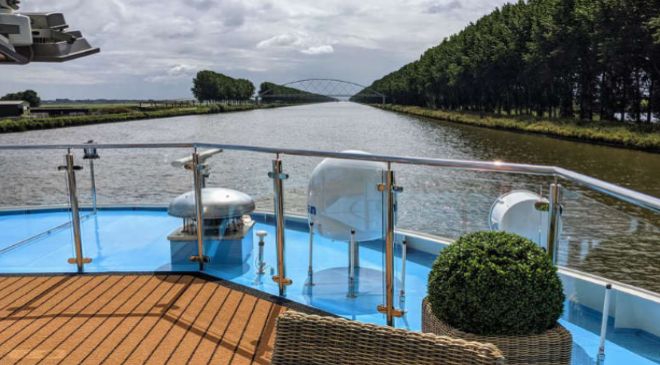The River Cruise Experience
River cruising shares many similarities with ocean cruising, but the two experiences are significantly different. So before you sign on to swap ocean waves for rippling rivers, here’s what you need to know
There’s a river cruising season
From the United States, you can cruise to the Caribbean year-round (bearing in mind that fares will cost more during the region’s high season, December through May). European river cruising, however, is seasonal, and ships are docked during winter’s coldest months, January and February. Come March, river ships are back on the water, where they remain until the European Christmas markets wrap up in December.
River ships are much smaller than ocean ships
On an ocean sailing, you may leave port with as many as 4,000 fellow passengers. River ships, which navigate narrow and shallow waterways, are significantly smaller, with only two or three decks and, at most, around 200 guests. I took my first river cruise last month on AmaWaterways’ new AmaSiena, which has a capacity of 156. Its largest, AmaMagna, accommodates 196 passengers and its smallest, Zambezi Queen, sails with just 48! The upside: River cruising offers an intimate experience; it’s always easy to find your way around the ship; and it’s a great option for older passengers and those with limited mobility. And if you’re prone to seasickness, fret not! River cruising is smooth sailing all the way!
Cabins are comparable
There’s no roughing it on a river cruise! The cabins may be fewer but they’re equally comfortable as those on ocean ships, with all the conveniences (air-conditioning; WI-FI; TV etc.) you’d expect. On AmaSiena, my room had two balconies, a marble-clad bathroom and a mini-fridge. Bonus: There are no inside cabins on river ships! The least expensive staterooms are on the lowest level, just at the water line, and have windows so you can watch “Swan TV” (the birds flock to the ships when they’re in port) at your leisure.
There are fewer dining choices
Today’s ocean ships have a slew of restaurants, from the breakfast buffet to coffee shops to sushi and burger bars. But river ships’ limited space means there may be only one main restaurant and, perhaps, a lounge for casual dining. However, although your options will be smaller your meals will likely be just as good, featuring fresh ingredients sourced in port that day. So you can enjoy poached salmon fresh from a Strasbourg stream, schnitzel for lunch in Heidelberg, and black forest cake after a hike through Germany’s Black Forest, knowing you’re eating local – and well!
It’s all about the sailing experience
Ocean cruise ships have all the bells and whistles: Rock-climbing walls, Broadway-style theaters, ice skating rinks, water parks and bowling alleys among them. On a river ship, diversions are more modest. AmaSiena had a fleet of bikes for independent exploration on shore; a small spa, fitness room and pool onboard; and entertainment included a pianist, violinist and singer. Truth is, there’s less to do on a river ship. The good news is that without a raft of activities to tempt you, you never feel guilty for just relaxing on your balcony and simply watching the world go by. And isn’t that what vacations are for?
The destinations are paramount
Big ships can be destinations in their own right. But river cruising puts the focus squarely on the places you visit. On a European river cruise, you’ll travel mostly by night and wake up in a new city or country. Exploration is easy since you’ll dock close to or often smack in the center of town. And it’s also encouraged since in most cases a daily shore tour is included in the cruise fare. On AmaSiena’s Captivating Rhine itinerary, we sailed from Amsterdam, The Netherlands through France and Germany and finished in Basel, Switzerland. Along the way, passengers could hike the hillsides of Heidelberg, sample coffee in Rüdesheim, and tour Cologne’s cathedral in Germany, and bike or stroll their way through Strasbourg, France, all at no extra charge.
You must comply with COVID protocols
Just as with a Caribbean sailing, on a European river cruise you’ll visit several different countries, all with differing entry requirements and COVID protocols. So be prepared to take several COVID tests and to complete online travel applications during your cruise. The line will keep you updated pre-departure, but it’s wise to watch the official tourism websites of the destinations you’ll be visiting as regulations can change swiftly.
There are no sea days
Since ports of call on a river cruise are closer to each other than on a Caribbean cruise, there’s no need to spend an entire day sailing from one to the other. You’ll either travel to your next port during sleeping hours or you may visit one port in the morning and another in the afternoon. Either way, there are no “sea days” on a river cruise. And since you simply walk off the ship when you arrive, there’s no time-consuming tendering into town, either. But there will be locks! I found it fascinating to watch as our vessel entered the gates, slowly descended below the mossy lock walls into near darkness, and them, with mere inches of clearance on either side, was lifted gently to the surface with the rising river. We went through a half-dozen locks during our cruise and each transit was equally captivating.
There’s not much to buy on board
With no onboard casinos or shopping arcades, there’s little to spend your money on beyond spa treatments or cocktails. The good news is that you can direct all your disposable dollars to stores and craftspeople local to the destinations you visit. Boosting the economy has never been so much fun!











































